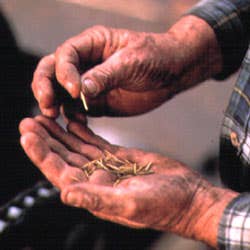
Truly Wild Rice
The real stuff actually is wild, and though it isn’t really rice, it certainly is tasty.
By law, real wild rice, the noncultivated seeds of Zizania aquatica—a tall grass indigenous to the lakes and rivers of Minnesota and Canada—must be gathered by hand, the same way that Chippewa Indians have harvested it for more than a thousand years. In a canoe, a team of two works the lakes, pulling reeds inward and sweeping the seeds off into the boat. On a good day, the team returns home knee-deep in the pale green rice. A windy storm, however, can destroy entire harvests, leaving boats empty—and prices even higher than usual.
The parching process, sometimes done over wood fires, imparts an almost smoky character to the rice. This character is largely lacking in so-called paddy rice, which accounts for about 90 percent of what is sold as wild rice today. Usually treated with chemicals, paddy rice is mechanically harvested and, though a perfectly good product, is inevitably less flavorful than the traditional kind.
Keep Reading
Continue to Next Story










